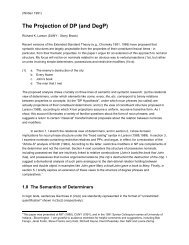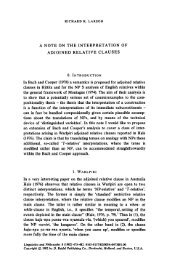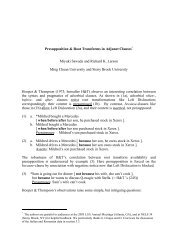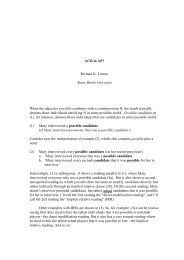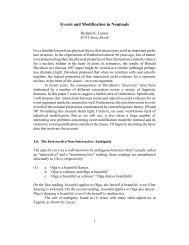Intensional Transitive Verbs and Abstract Clausal Complementation
Intensional Transitive Verbs and Abstract Clausal Complementation
Intensional Transitive Verbs and Abstract Clausal Complementation
Create successful ePaper yourself
Turn your PDF publications into a flip-book with our unique Google optimized e-Paper software.
<strong>Intensional</strong> <strong>Transitive</strong> <strong>Verbs</strong> <strong>and</strong> <strong>Abstract</strong> <strong>Clausal</strong> <strong>Complementation</strong><br />
some feature(s) to be responsible for each movement:<br />
(46) a. V [ CP [ VP HAVE a cracker] [ C’ for [ AgrsP ...t... ]]]<br />
b. V-for-HAVE [ CP [ VP t a cracker] [ C’ t [ AgrsP ...t... ]]]<br />
Chomsky (1995) suggests that some LF incorporations might be accounted for by a lexical feature [affix];<br />
forms bearing this feature will need to adjoin to a head for convergence, etc. As we have noted, however,<br />
the specific cooccurrence relation between verbs of the want-class <strong>and</strong> the lexical form HAVE suggests a<br />
specific feature-checking relation between the matrix <strong>and</strong> complement V. Furthermore, in virtue of the<br />
unacceptability of passive examples like *A cracker is wanted to be had, it is necessary for us to assume<br />
that only abstract HAVE carries the relevant feature in English <strong>and</strong> hence only clausal complements<br />
containing abstract HAVE undergo restructuring. The answers to these questions evidently wait upon a<br />
more detailed underst<strong>and</strong>ing of restructuring generally within the current framework. For the present we<br />
will simply assume, given the reality of the restructuring phenomenon, that some answer can be given<br />
<strong>and</strong> that this answer will extend to the constructions treated here, obviously a non-trivial assumption.<br />
A more concrete issue concerns the level at which the incorporations proposed here take place. If<br />
incorporation takes place before Spell Out, then we get some purchase on well-known "complementizer<br />
doubling" phenomena occurring with certain infinitives. (47a,b) give familiar cases where (the infinitival<br />
complementizer) for shows up twice in association with a single complement. A natural account of this<br />
within Minimalism is that incorporation, like all movement, involves copying, <strong>and</strong> that (47a,b) involve both<br />
the head <strong>and</strong> the tail in the movement chain (for, for) being phonetically realized:<br />
(47) a. [for Bob to be elected] was fervently hoped for in some segments of the population.<br />
b. What Max is praying for is [for Lyndon to win].<br />
Nonetheless, the situation is not straightforward. Although the complementizer may incorporate pre-Spell<br />
Out in the overt clausal construction, in the surface transitive construction, for <strong>and</strong> its trailing DP can be<br />
fronted together without doubling (48a). Notice, furthermore that for+DP can be fronted with its trailing<br />
adverbial, without losing the reading in which the adverb modifies the implicit HAVE verb (48b). In view of<br />
this, it seems we must analyze examples like (48a) as involving the fronting of the entire complement<br />
clause as in (48c), where the source-position copy is indicated in italics:<br />
(48) a. [For such things] one should never hope (??for).<br />
b. [for a cracker tomorrow] Polly is hoping.<br />
c. [For PRO HAVE such things] one should never hope [for PRO HAVE such things]<br />
Presumably, whereas the fronted elements are active at PF, at LF it is the source-copy portions that<br />
undergo incorporation <strong>and</strong> that are relevant for semantic interpretation. Hence we must assume that the<br />
incorporations involved with intensional transitives occur at LF.<br />
features on for. This proposal is plausible given the evident dependence between the complementizer in infinitives<br />
<strong>and</strong> the embedded tense.<br />
21



